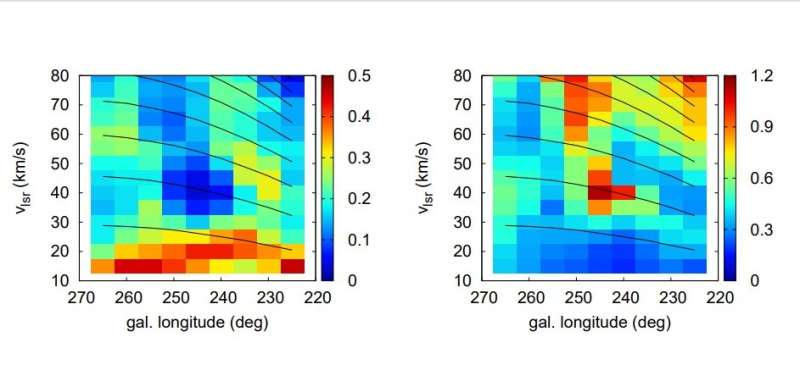September 24, 2018 report
Researchers study a neutral hydrogen supershell in the Milky Way

A duo of researchers from the Czech Republic has performed a study of the neutral hydrogen supershell known as GS242-03+37, a large structure in the Milky Way galaxy. The research, presented in a paper published September 11 on arXiv.org, provides insights into the nature of this supershell and into its interactions with surroundings.
Supershells, also called superbubbles, are large cavities hundreds of light-years across containing hot gas atoms. The gaseous material in supershells, carved out by supernovae and stellar winds, is blown against surrounding interstellar medium as it is less dense than the medium.
Discovered in 1979, GS242-03+37 is a neutral hydrogen supershell located in the outer Milky Way. It is a dominant object observed in the neutral hydrogen maps of the galaxy, and its size and position make it an excellent laboratory for astronomers studying the effects of large shells on their surroundings.
Sona Ehlerova and Jan Palous from the Astronomical Institute of the Czech Academy of Sciences in Prague, Czech Republic, decided to learn more about GS242-03+37. Based on neutral hydrogen and carbon monoxide radio observations, as well as available data regarding star clusters in the area, the researchers conducted numerical simulations of the supershell's structure, which allowed them to determine crucial parameters of this cavity.
"We perform numerical simulations of the structure with the simplified hydrodynamical code RING, which uses the thin-shell approximation. The best fit is found by a comparison with the HI data, and then we compare the model with the distribution of star clusters near this supershell," the astronomers wrote in the paper.
Ehlerova and Palous found that GS242-03+37 is a relatively old structure when compared to other supershells. They estimate that has an age of at least 80 million years, most likely around 120 million years. According to the researchers, GS242-03+37 could survive so long in the galaxy because it is luckily placed very near the corotation radius of the spiral structure and therefore is not disturbed by the passage of the spiral arms, which could destroy the shell.
The findings detailed in the paper also put the current status of GS242-03+37 into question. The researcher calculated that the structure is not as energetic as was once thought. Therefore, it may not be a supershell in the strict "energetic" definition.
"Given all the uncertainties and approximations, we still refer to GS242-03+37 as a supershell, even though the basic model suggests its energy is lower than the minimum value of the energy of the supershell," the paper reads.
The study also suggests that there is a correlation between GS242-03+37 and the distribution of young (less than 120 million years old) star clusters. The authors of the paper found that young clusters tend to be preferentially located in walls of the supershell.
More information: GS242-03+37: a lucky survivor in the galactic gravitational field, arXiv:1809.03863 [astro-ph.GA] arxiv.org/abs/1809.03863
© 2018 Phys.org





















